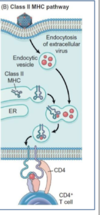Lecture 5: Antiviral immunity and Prophylaxis Flashcards
(36 cards)
What are the parts of the innate immune system? Adaptive immune system?
- Innate immunity: Natural barriers, IFN, NK, Macrophages.
- Adaptive immunity: Cytotoxic T cells, antiviral antibodies, helper T cells
Where are B cells made in the bird?
Bursa of fabricius
What antibody is present mainly in the mucus membranes? What about near the alveoli?
MM: IGA is present here mostly.
IgG is alveoli areas
What size of foreign antibodies can pass through the nose, bronchi, bronchioles, alveoli?
- Foreign antigen through nose 15 mcL
- Bronchi : 10 mcL
- Bronchioles: 5 mcL
- Alveoli: 1 mcL

What are the stages of phagocytosis?
- Stages of phagocytosis
- CAID -> Chemotaxis -> adherence -> Ingestion -> Destruction

What is the purpose of IFN’s? Are IFN’s specific to viruses? What about cell specific? Species specidic?
- IFN -> Chemical produced by viral infected cells to alert for response to viral infections.
- IFNs not virus specific but cell specific in production and effects and is Species specific.
What are IFN’s? What can inactivate them?
- Glycoprotein’s, stable at ph2 and resistant at 56 degrees c for 1 hour
- Can be inactivated by treatment with proteolytic enzymes.
What is the purpose of developing a fever when sick? What does the fever mean?
- Fever helps induce immune response.
- Fever is important. It is synthesizing the immune response. The more fever the larger the immune response. The fever will trigger IFN when it gets above 40 degrees c
Which IFN has the most genes that encode it?
- IFN-a : 20 genes incode this
- 1 gene encodes Beta and gamma
What is the definition of an IFN?
IFNs: sets of proteins released by the virus infected cells which react with the surrounding non infected cells rendering them resistant to this type of viral infection
What are type 1 IFNs?
IFN alpha (leukocyte IFN (monocytes) B lymphocytes)
IFN beta (fibroblast IFN, Epithelial cells)
What are type 2 IFNs?
IFN gamma
(Immune IFN ( some activated t cells, NK cells)
What are IFN inducers?
- Infectious or inactivated virus induce the production of IFNs for 20-50 hrs after exposure
- Viruses that might multiply slowly and not damage the cell or the synthesis of protein early are good IFN inducers
- Cells of bone marrow, spleen, and macrophages are highly IFN producers
- Polynucleotides (Poly-IC) are good IFN inducers
What is the antiviral mechanisms induced by IFNs?
- 1.Block viral mRNA synthesis
- 2.Block the translation of viral mRNA

How does antigen processing/ display occur with MHC - I Molecules?
Viral peptides are produced from proteins in the cytosol and transported to the ER to bind to Class I MHC complex
The peptide/Class I MHC complex transported to the cell surface and displayed for recognition by the CD8+

How does antigen processing/ display occur with MHC - II Molecules?
Viral proteins are ingested into vesicles and degraded into peptides -\> They bind to the class II-MHC that transported to the same vesicles -\> The class II-peptide complex are expressed on the cell surface and recognized by CD4 T cells

What immune cells are important for stimulating NK cells?
decrease in MHC I, increase in stimulatory ligand, IFN alpha and Beta , and IL- 12, IL 18
How do B lymphocytes react to a virus?
B lymphocytes trigger plasma cells and antibody secretion.
How do monoclonal cells prevent virus infectiow
They act as a barrier, so it competes for the receptors on the cell and the virus cant transmit active infection.
How do CD4+ T lymphocytes and macrophages prevent virus infection?
- releases cytokines which:
- activates macrophages
- Inflammation
- Stimulates B lymphocytes
How do CD8+ T lymphocytes and macrophages prevent virus infection?
This cell is a cytotoxic t cell. It will kill the infected cell and cut its losses.
What cells are involved in the immune response to viral infection? When does each cell peak? How long does the innate immune system last? When does the adaptive immune system kick in?
- ) Type - 1 IFN’s ( peak about day 2 and then declines)
- ) NK cells ( peaks about day 3 and then declines)
- ) CTL (Starts around day 2 but plateus around day 7 then declines around day 10)
- ) Antibodies (Starts around day 5 sometimes, but mostly at day 7)
Innate immunity begins at day 1-5, at day 5 adaptive immune system takes over.
What does CD4+ T cells do when they recognize a virus? CD8+
CD 4+: Attract other immune cells and stimulate B- cells to produce
CD8+ : -Slow down the viral infection
-Kill the virus infected cells
Cytotoxic-T cells: Kills the virus-infected cells through
the release of some toxic chemical mediators
What are TCRs?
T cell receptors (TCRs): specifically recognize and bind to some antigenic peptide bound to MHC molecules










